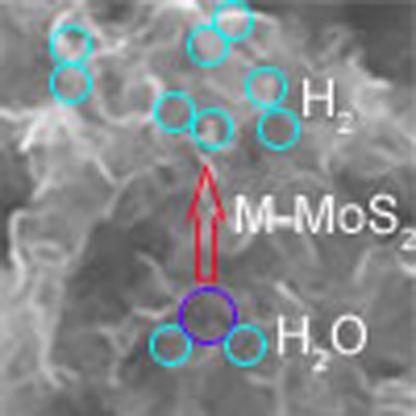- Record: found
- Abstract: found
- Article: found
Pure and stable metallic phase molybdenum disulfide nanosheets for hydrogen evolution reaction

Read this article at
Abstract
Metallic-phase MoS 2 (M-MoS 2) is metastable and does not exist in nature. Pure and stable M-MoS 2 has not been previously prepared by chemical synthesis, to the best of our knowledge. Here we report a hydrothermal process for synthesizing stable two-dimensional M-MoS 2 nanosheets in water. The metal–metal Raman stretching mode at 146 cm −1 in the M-MoS 2 structure, as predicted by theoretical calculations, is experimentally observed. The stability of the M-MoS 2 is associated with the adsorption of a monolayer of water molecules on both sides of the nanosheets, which reduce restacking and prevent aggregation in water. The obtained M-MoS 2 exhibits excellent stability in water and superior activity for the hydrogen evolution reaction, with a current density of 10 mA cm −2 at a low potential of −175 mV and a Tafel slope of 41 mV per decade.
Abstract
 Metallic molybdenum disulfide is a metastable phase of the material. Here, the authors
synthesize two-dimensional metallic molybdenum disulfide nanosheets, stabilized by
adsorbed aqueous monolayers, and evaluate their catalytic hydrogen evolution activity.
Metallic molybdenum disulfide is a metastable phase of the material. Here, the authors
synthesize two-dimensional metallic molybdenum disulfide nanosheets, stabilized by
adsorbed aqueous monolayers, and evaluate their catalytic hydrogen evolution activity.
Related collections
Most cited references11
- Record: found
- Abstract: found
- Article: found
Atomically thin MoS2: A new direct-gap semiconductor
- Record: found
- Abstract: found
- Article: not found
Phase-engineered low-resistance contacts for ultrathin MoS2 transistors.
- Record: found
- Abstract: found
- Article: not found